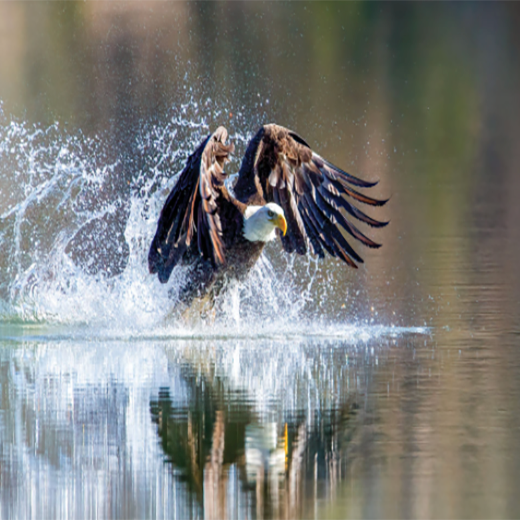|
Eagles may get exposed to a neurotoxin through their prey. MIKE MARTIN By Erik Stokstad — Mar. 25, 2021
More than 25 years ago, biologists in Arkansas began to report dozens of bald eagles paralyzed, convulsing, or dead. Their brains were pocked with lesions never seen before in eagles. The disease was soon found in other birds across the southeastern United States. Eventually, researchers linked the deaths to a new species of cyanobacteria growing on an invasive aquatic weed that is spreading across the country. The problem persists, with the disease detected regularly in a few birds, yet the culprit’s chemical weapon has remained unknown. Today in Science, a team identifies a novel neurotoxin produced by the cyanobacteria and shows that it harms not just birds, but fish and invertebrates, too. “This research is a very, very impressive piece of scientific detective work,” says microbiologist Susanna Wood of the Cawthron Institute. An unusual feature of the toxic molecule is the presence of bromine, which is scarce in lakes and rarely found in cyanobacteria. One possible explanation: the cyanobacteria produce the toxin from a bromide-containing herbicide that lake managers use to control the weed. The discovery highlights the threat of toxic cyanobacteria that grow in sediment and on plants, Wood says, where routine water quality monitoring might miss them. The finding also equips researchers to survey lakes, wildlife, and other cyanobacteria for the new toxin. “It will be very useful,” says Judy Westrick, a chemist who studies cyanobacterial toxins at Wayne State University and was not involved in the new research. “I started jumping because I got so excited.” Wildlife biologists with U.S. Geological Survey and local institutions first detected the eagles’ brain disease, now called vacuolar myelinopathy, at DeGray Lake in Arkansas in late 1994. They soon learned that coots and owls at the lake were dying with similar brain lesions. The researchers ruled out industrial pollutants and infectious disease, and they couldn’t find any algal toxins in the water. Then funding ran out, and the scientists turned to other projects. But Susan Wilde, an aquatic ecologist at the University of Georgia, Athens, persisted, with intermittent funding. “I just had a lot of colleagues and graduate students that were self-propelled to work on this.” Birds were dying at lakes and reservoirs throughout the southeast, and at every lake her team visited, they found Hydrilla verticillata, a tough and fast-growing invasive plant. In 2001, Wilde noticed dark spots on the underside of the leaves. Back in the lab, she put a sample under a microscope and shone light that makes cyanobacteria glow red. The whole leaf lit up. “I was running around the hallways,” Wilde recalls. “It was kind of a eureka moment.” The cyanobacterium was a new species, which Wilde named Aetokthonos hydrillicola in 2014. She suspected it was producing a neurotoxin. To confirm that hunch, Wilde and colleagues fed hydrilla to mallards in the lab. Only those that ate leaves harboring the cyanobacteria developed brain lesions. Next, a group led by Timo Niedermeyer, a natural products chemist at Martin Luther University Halle-Wittenberg, figured out how to culture the cyanobacterium and initially found that the lab-grown strain did not cause lesions in chickens. “Huge disappointment,” he recalls. But when they added bromide salts to the culture medium, the cyanobacteria began to produce the neurotoxin. In further tests, Wilde and colleagues found that the toxin also kills fish, insects, and worms. “This is a really potent neurotoxin, even at fairly low levels,” she says. Wilde suspects mammals are also vulnerable; her colleagues hope to test the compound on mice. Niedermeyer’s lab discovered the neurotoxin was fat-soluble, which is unusual for cyanobacterial toxins and suggests it can accumulate in tissues. Fish and birds are exposed when they eat hydrilla coated with the new species of cyanobacteria, and then the toxin may move through the food web as eagles and owls consume afflicted prey. “If verified, bioaccumulation has important consequences to the whole ecosystem and human health” if people consume toxin-contaminated fish or waterfowl, says Kaarina Sivonen, a microbiologist at the University of Helsinki. The cyanobacterium appears to get the bromide it needs to make the toxin from hydrilla, which can concentrate bromide from lake sediment in its leaves. Bromides are rare in freshwater, but they could be eroding from rocks, or they might originate from coal-fired power plants. Other sources could include brominated flame retardants, fracking fluids, and road salt. Wilde suspects one local source might be an herbicide, diquat dibromide, that is used to kill hydrilla. Wilde points to recent success managing the weed without chemicals, by stocking lakes with fish that eat hydrilla. Although grass carp are not desirable for fishing, using sterile carp would ensure the population would die out once its work was done. The Army Corps of Engineers has already released the fish into a reservoir on the border of Georgia and South Carolina, where they removed the hydrilla. Since then, no more sick eagles have been found. Saving the birds from the neurotoxin will be a long fight, however, because both hydrilla and the cyanobacteria are exceptionally hardy. The invasive plant is likely to continue to be spread by boats, researchers say, and perhaps also migrating birds. “We should expect the cyanobacterium to follow,” says George Bullerjahn, a microbiologist at Bowling Green State University, “and the threat of toxicity to become a broader issue.” Comments are closed.
|
Contact UsFollow us on Facebook and YouTube
|






